Mobile Network Operators (MNOs) and Mobile Virtual Network Operators (MVNOs) are two types of mobile service providers that operate in the United States of America. While they both offer mobile services, there are some key differences between the two.
MNOs are the primary mobile service providers in the United States. They own and operate their own physical network infrastructure, including cell towers and other equipment. MNOs are responsible for maintaining their network, providing customer support, and billing their customers directly.

Table of Contents
What is a Mobile Virtual Network Operator (MVNO)?
Mobile Virtual Network Operators (MVNOs), on the other hand, do not own their own physical network infrastructure. Instead, they lease network capacity from MNOs and resell it to their own customers. MVNOs typically do not have their own cell towers or other network equipment, but instead rely on the network infrastructure of the MNO they are leasing from. MVNOs are responsible for providing customer support and billing their customers, but they do not have to maintain their own network infrastructure. Examples of MVNOs in the United States include Boost Mobile, Cricket Wireless, and Straight Talk.
Similarities between MNOs and MVNOs
Despite their differences, MNOs and MVNOs share some similarities. Both types of mobile service providers offer similar services, such as voice, text, and data plans. They also both offer prepaid and postpaid plans, and many offer unlimited data plans as well. In addition, both MNOs and MVNOs offer a variety of devices, including smartphones and tablets, for purchase.
Differences between MNOs and MVNOs
One of the biggest differences between MNOs and MVNOs is pricing. MNOs typically charge more for their services than Mobile Virtual Network Operators (MVNOs), as they have to recoup the costs of building and maintaining their own network infrastructure. MVNOs, on the other hand, are able to offer lower prices by leasing network capacity from MNOs and reselling it to their own customers.
Another difference between MNOs and MVNOs is coverage. MNOs typically have better coverage than MVNOs, as they own and operate their own network infrastructure. MVNOs, on the other hand, may have more limited coverage, as they are dependent on the network infrastructure of the MNO they are leasing from.
How Mobile Virtual Network Operators (MVNOs) operate in the United States
In the United States, MNOs and MVNOs are both regulated by the Federal Communications Commission (FCC), which sets rules and guidelines for the mobile industry. Both MNOs and MVNOs must comply with FCC regulations regarding network security, emergency services, and other issues.
MNOs and MVNOs also compete with each other in the mobile market. While Mobile Network Operators (MNOs) generally have a larger market share and more resources, Mobile Virtual Network Operators (MVNOs) are able to offer lower prices and more flexible plans. This competition has led to a variety of pricing and plan options for consumers, as well as increased innovation in the mobile industry.
Examples of Mobile Virtual Network Operators in the United States
Here are some examples of Mobile Virtual Network Operators (MVNOs) in the USA and the carriers they are riding on:
- Boost Mobile: Boost Mobile is an MVNO that operates on the T-Mobile and AT&T networks.
- Cricket Wireless: Cricket Wireless is an MVNO that operates on the AT&T network.
- Metro by T-Mobile: Metro by T-Mobile is an MVNO that operates on the T-Mobile network.
- Straight Talk: Straight Talk is an MVNO that operates on the AT&T, T-Mobile, and Verizon networks.
- Ting: Ting is an MVNO that operates on the T-Mobile and Verizon networks.
- TracFone: TracFone is an MVNO that operates on the AT&T, T-Mobile, and Verizon networks.
- US Mobile: US Mobile is an MVNO that operates on the Verizon and T-Mobile networks.
You can access a more detailed list of the top Mobile Virtual Network Operators (MVNOs) in the United States. Note that these carriers may change their network partners over time, so it is important to check with each carrier for the most up-to-date information.
Recap
Mobile Network Operators (MNOs) and Mobile Virtual Network Operators (MVNOs) are two types of mobile service providers that operate in the United States. While MNOs own and operate their own physical network infrastructure, MVNOs lease network capacity from MNOs and resell it to their own customers.
Both types of mobile service providers offer similar services, but differ in pricing and coverage. MNOs typically charge more for their services but have better coverage, while MVNOs are able to offer lower prices but may have more limited coverage. Both MNOs and MVNOs are regulated by the FCC and compete with each other in the mobile market.

